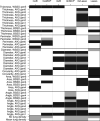LINKING LUNG AIRWAY STRUCTURE TO PULMONARY FUNCTION VIA COMPOSITE BRIDGE REGRESSION
- PMID: 28280520
- PMCID: PMC5340208
- DOI: 10.1214/16-AOAS947
LINKING LUNG AIRWAY STRUCTURE TO PULMONARY FUNCTION VIA COMPOSITE BRIDGE REGRESSION
Abstract
The human lung airway is a complex inverted tree-like structure. Detailed airway measurements can be extracted from MDCT-scanned lung images, such as segmental wall thickness, airway diameter, parent-child branch angles, etc. The wealth of lung airway data provides a unique opportunity for advancing our understanding of the fundamental structure-function relationships within the lung. An important problem is to construct and identify important lung airway features in normal subjects and connect these to standardized pulmonary function test results such as FEV1%. Among other things, the problem is complicated by the fact that a particular airway feature may be an important (relevant) predictor only when it pertains to segments of certain generations. Thus, the key is an efficient, consistent method for simultaneously conducting group selection (lung airway feature types) and within-group variable selection (airway generations), i.e., bi-level selection. Here we streamline a comprehensive procedure to process the lung airway data via imputation, normalization, transformation and groupwise principal component analysis, and then adopt a new composite penalized regression approach for conducting bi-level feature selection. As a prototype of composite penalization, the proposed composite bridge regression method is shown to admit an efficient algorithm, enjoy bi-level oracle properties, and outperform several existing methods. We analyze the MDCT lung image data from a cohort of 132 subjects with normal lung function. Our results show that, lung function in terms of FEV1% is promoted by having a less dense and more homogeneous lung comprising an airway whose segments enjoy more heterogeneity in wall thicknesses, larger mean diameters, lumen areas and branch angles. These data hold the potential of defining more accurately the "normal" subject population with borderline atypical lung functions that are clearly influenced by many genetic and environmental factors.
Keywords: bi-level variable selection; composite penalization; feature extraction; lung airway data; pulmonary function tests.
Figures





Similar articles
-
[Standard technical specifications for methacholine chloride (Methacholine) bronchial challenge test (2023)].Zhonghua Jie He He Hu Xi Za Zhi. 2024 Feb 12;47(2):101-119. doi: 10.3760/cma.j.cn112147-20231019-00247. Zhonghua Jie He He Hu Xi Za Zhi. 2024. PMID: 38309959 Chinese.
-
Understanding the contribution of native tracheobronchial structure to lung function: CT assessment of airway morphology in never smokers.Respir Res. 2015 Feb 14;16(1):23. doi: 10.1186/s12931-015-0181-y. Respir Res. 2015. PMID: 25848985 Free PMC article.
-
Optimal graph search based segmentation of airway tree double surfaces across bifurcations.IEEE Trans Med Imaging. 2013 Mar;32(3):493-510. doi: 10.1109/TMI.2012.2223760. Epub 2012 Oct 10. IEEE Trans Med Imaging. 2013. PMID: 23070299 Free PMC article.
-
MDCT assessment of airway wall thickness in COPD patients using a new method: correlations with pulmonary function tests.Eur Radiol. 2008 Dec;18(12):2731-8. doi: 10.1007/s00330-008-1089-4. Epub 2008 Jul 19. Eur Radiol. 2008. PMID: 18641993
-
Quantitative computed tomography measurements to evaluate airway disease in chronic obstructive pulmonary disease: Relationship to physiological measurements, clinical index and visual assessment of airway disease.Eur J Radiol. 2016 Nov;85(11):2144-2151. doi: 10.1016/j.ejrad.2016.09.010. Epub 2016 Sep 13. Eur J Radiol. 2016. PMID: 27776670 Free PMC article. Review.
Cited by
-
Integrative multi-view regression: Bridging group-sparse and low-rank models.Biometrics. 2019 Jun;75(2):593-602. doi: 10.1111/biom.13006. Epub 2019 Mar 29. Biometrics. 2019. PMID: 30456759 Free PMC article.
References
-
- Becklake MR. Concepts of normality applied to the measurement of lung function. The American Journal of Medicine. 1985;80:1158–1164. - PubMed
-
- Breheny P. The group exponential lasso for bi-level variable selection 2013 - PubMed
-
- Chen K, Chan KS. Subset ARMA Selection via the Adaptive Lasso. Statistics and Its Interface. 2011;4:197–205.
Grants and funding
LinkOut - more resources
Full Text Sources
Other Literature Sources
Research Materials
